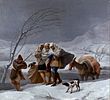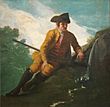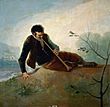Summer (Goya) facts for kids
Quick facts for kids Summer |
|
|---|---|
 |
|
| Artist | Francisco de Goya |
| Year | 1786 to 1787 |
| Catalogue | P000794 |
| Medium | Oil on Canvas |
| Movement | Dark-Romanticism |
| Dimensions | 277 cm × 642 cm (109 in × 253 in) |
| Location | Museo del Prado, Madrid |
Summer (in Spanish, El verano) is also known as The Threshing Floor (in Spanish, La era). It is a very large painting by Francisco de Goya. He created it as a design for a tapestry, which is a woven picture used to decorate walls.
Goya painted Summer between 1786 and 1787. It was part of a group of designs for the Royal Tapestry Factory in Spain. These tapestries were made for the dining room of the Prince and Princess of Asturias (who later became King Charles IV and Queen Maria Luisa).
Today, the main painting is kept at the Museo del Prado in Madrid. A smaller, earlier sketch of the work, called The Threshing Floor, is in the Lázaro Galdiano Museum.
What is a Tapestry Cartoon?
A tapestry cartoon is a large drawing or painting that artists make as a guide for weaving a tapestry. Weavers would use these detailed designs to create the final woven artwork. Goya made many of these cartoons for the Spanish royal family.
Goya's Royal Tapestries
Francisco de Goya was a very important Spanish artist. He worked for the Spanish royal family for many years, starting in 1774. He painted many designs for the Royal Tapestry Factory.
Goya created 63 large tapestry cartoons for King Charles III. Twelve of these designs are known as the Fifth Series of Francisco Goya’s Tapestry Cartoons. Summer is one of the paintings in this series.
All the paintings in the Fifth Series were made for the dining room of the Prince of Asturias (who would become King Charles IV) and his wife, Marie Louise of Parma. This room was in the Pardo Palace. Goya painted Summer in the fall of 1786.
For a long time, this painting was thought to be lost. But in 1869, it was found in the basement of the Royal Palace of Madrid. It was then moved to the Prado Museum in 1870, where you can see it today in room 943.
- Fig. 1; Some of Goya's other tapestry cartoons
Goya's Changing Art Style
Goya's art style changed a lot during his life. His earlier works often showed happy and peaceful scenes. They made viewers feel festive and calm.
However, Goya became very ill in 1792. Many people think this illness caused his art to become darker. Later, the Peninsular War (1808), when Napoleon invaded Spain, also greatly affected him. Goya saw terrible things during this war.
After these events, Goya's art style shifted. He started to paint more serious and sometimes scary themes. This change is often linked to a style called Dark Romanticism. For example, his series The Disasters of War shows the horrors he witnessed.
Even in his tapestry designs, Goya began to include elements of this darker style. This shows how his art changed over time, reflecting his experiences and feelings.
See also
 In Spanish: La era para niños
In Spanish: La era para niños
- List of works by Francisco Goya









